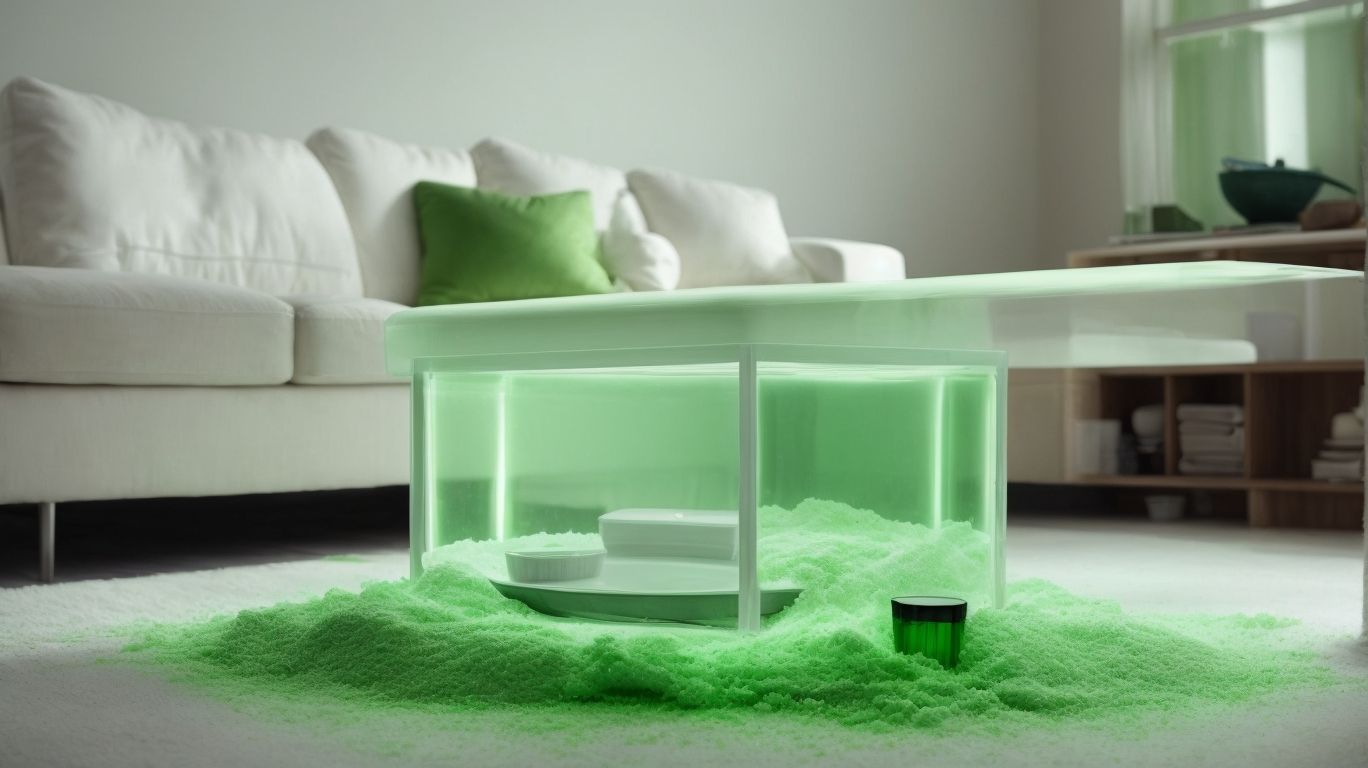Formaldehyde is a colorless, strong-smelling gas that is commonly used in household products as a preservative and to prevent microbial growth. While this chemical is effective in preserving products, it can pose significant health risks to humans.
Formaldehyde can be found in various household products, building materials, and personal care products. According to research by the National Cancer Institute, formaldehyde exposure can lead to health problems such as respiratory irritation, allergic reactions, and even cancer.
- In Household Products: Formaldehyde can be found in cleaning products, air fresheners, furniture and wood products, and even some cosmetics.
- In Building Materials: Building materials such as plywood, particleboard, and even some insulation products contain formaldehyde.
- In Personal Care Products: Formaldehyde is used as a preservative in various personal care products such as shampoos, hair straighteners, and nail polish.
Exposure to formaldehyde can have both short-term and long-term health effects. Short-term exposure can lead to irritation of the eyes, nose, and throat, while long-term exposure can increase the risk of respiratory issues, as well as certain types of cancer.
To protect yourself from formaldehyde exposure, there are several preventive measures you can take:
- Avoid Products Containing Formaldehyde: Read product labels and avoid products that contain formaldehyde.
- Proper Ventilation: Ensure proper ventilation in your home to reduce the concentration of formaldehyde in the air.
- Use Protective Gear: When using products that contain formaldehyde, wear protective gear such as gloves and a mask.
- Regular Cleaning: Regularly clean and dust to reduce the levels of formaldehyde in your home.
There are alternatives to formaldehyde-containing products that are safer and healthier:
- Natural Cleaning Products: Use natural cleaning products such as vinegar and baking soda instead of products that contain formaldehyde.
- Formaldehyde-free Building Materials: Choose building materials that are free from formaldehyde, such as solid wood or low-emitting products.
- Organic Personal Care Products: Opt for organic personal care products that do not use formaldehyde as a preservative.
There are regulations and guidelines in place for formaldehyde levels in household products and building materials. The Occupational Safety and Health Administration (OSHA) has set permissible exposure limits for formaldehyde in the workplace, and the Environmental Protection Agency (EPA) regulates the amount of formaldehyde emitted from various products. It is important to be aware of these guidelines and choose products that comply with them to minimize exposure to formaldehyde.
Key Takeaways:
What Is Formaldehyde?

Photo Credits: Chemicalglossary.Net by Russell Carter
Formaldehyde is a colorless gas with a pungent odor that is frequently present in household items. It is a chemical compound made up of carbon, hydrogen, and oxygen. Formaldehyde is commonly used in various products, including construction materials, household cleaning products, and personal care items. Exposure to elevated levels of formaldehyde can have adverse effects on human health, such as respiratory issues and skin irritation. It is crucial to be mindful of the existence of formaldehyde in products and take appropriate measures to reduce exposure.
Where Is Formaldehyde Found?

Photo Credits: Chemicalglossary.Net by Jack Thomas
Despite its widespread use, formaldehyde poses significant health risks and is classified as a known carcinogen by the International Agency for Research on Cancer. In this section, we will uncover the various sources of formaldehyde exposure, starting with its presence in household products. We will also discuss how building materials can release formaldehyde into the air and how personal care products may contain this harmful chemical. By understanding where formaldehyde is found, we can make informed decisions to protect ourselves and our families.
1. In Household Products
Household products may contain formaldehyde, a harmful chemical known to cause health issues. To minimize exposure, it is important to follow these steps:
- Read labels: Be sure to check for ingredients such as formalin, methylene glycol, or formaldehyde releasers.
- Avoid certain products: Stay away from items like cleaning agents, air fresheners, and furniture that are known to contain formaldehyde.
- Choose safer alternatives: Opt for natural cleaning products, fragrance-free options, and materials that are free of formaldehyde.
- Ensure proper ventilation: Improve air circulation by opening windows and using exhaust fans.
- Wear protective gear: When handling potentially contaminated products, protect yourself by using gloves, masks, and goggles.
- Maintain cleanliness: Regularly cleaning and dusting your home can help reduce the buildup of formaldehyde.
2. In Building Materials
Building materials can be a significant source of formaldehyde exposure. To minimize the risk, consider the following steps when selecting building materials:
- Choose formaldehyde-free options: Look for materials labeled as formaldehyde-free, such as zero-VOC (volatile organic compound) paints and adhesives.
- Opt for low-emitting products: Select building materials with low formaldehyde emissions, indicated by certifications like CARB Phase 2 or GreenGuard.
- Ventilate properly: Ensure good ventilation during and after construction to reduce formaldehyde concentrations indoors.
- Use protective gear: Wear gloves, masks, and goggles when handling materials containing formaldehyde.
- Regularly maintain and clean: Regularly clean and maintain building materials to prevent the release of formaldehyde.
- In Building Materials: Take these precautions to minimize formaldehyde exposure when working with building materials.
3. In Personal Care Products
Personal care products can be a significant source of formaldehyde exposure. To minimize your risk, follow these steps:
- Read labels: Look for products labeled “formaldehyde-free” or “no formaldehyde added”.
- Avoid certain ingredients: Check for formaldehyde-releasing preservatives like quaternium-15, diazolidinyl urea, and DMDM hydantoin.
- Choose natural alternatives: Opt for organic personal care products that use plant-based ingredients instead of synthetic chemicals.
- Do a patch test: Test new products on a small area of your skin to check for any allergic reactions.
- Stay informed: Keep up with the latest research and news on formaldehyde in personal care products, especially in regards to ingredient lists.
Pro-tip: Consider making your own DIY personal care products using natural ingredients to have more control over the ingredients you use on your body.
What Are the Health Effects of Formaldehyde Exposure?

Photo Credits: Chemicalglossary.Net by Ryan Lewis
Formaldehyde is a commonly used chemical in household products, but its presence can have serious health consequences. In this section, we will uncover the potential health effects of exposure to formaldehyde. From short-term effects to long-term consequences, we’ll examine the various ways in which this chemical can impact our health. By understanding these risks, we can make informed decisions about the products we use in our homes.
1. Short-term Exposure
Short-term exposure to formaldehyde can have immediate health effects. To protect yourself, follow these steps:
- Avoid products containing formaldehyde, such as certain cleaning agents or cosmetics.
- Ensure proper ventilation in your living space to reduce the concentration of formaldehyde.
- Use protective gear like gloves and masks when handling materials containing formaldehyde.
- Regularly clean your home to minimize the buildup of formaldehyde.
Consider using alternatives like natural cleaning products, formaldehyde-free building materials, and organic personal care products. It is important to be aware of regulations and guidelines for formaldehyde levels in order to stay safe.
2. Long-term Exposure
Long-term exposure to formaldehyde can have serious health effects. To protect yourself, consider taking the following steps:
- Limit exposure: Minimize the use of formaldehyde-containing products in your home and workplace.
- Improve ventilation: Ensure proper airflow by opening windows, using exhaust fans, or installing air purifiers.
- Wear protective gear: When working with formaldehyde, use gloves, goggles, and masks to reduce direct contact and inhalation.
- Maintain cleanliness: Regularly clean surfaces and objects to remove any formaldehyde residue.
By implementing these measures, you can reduce the risks associated with long-term exposure to formaldehyde.
How Can You Protect Yourself from Formaldehyde Exposure?

Photo Credits: Chemicalglossary.Net by Christian Lee
Exposure to formaldehyde in household products can have serious health consequences, from respiratory issues to cancer. In this section, we will discuss how you can protect yourself and your family from the hidden dangers of formaldehyde. We’ll cover simple steps such as avoiding products that contain formaldehyde, ensuring proper ventilation in your home, using protective gear when handling certain products, and regularly cleaning your living space to reduce exposure. Let’s dive into these practical ways to safeguard your health.
1. Avoid Products Containing Formaldehyde
To minimize exposure to formaldehyde and avoid products containing it, follow these steps:
- Thoroughly read product labels and avoid those that contain formaldehyde or formaldehyde-releasing ingredients.
- Consider opting for natural or organic alternatives, as they are less likely to contain formaldehyde.
- Check for third-party certifications such as Green Seal or EcoCert, which indicate that the product is formaldehyde-free.
- Choose building materials that are formaldehyde-free, such as formaldehyde-free plywood or low-emission carpets.
- Select personal care products that are labeled as “formaldehyde-free” or “no formaldehyde-added.”
By following these steps, you can reduce your exposure to formaldehyde and protect your health. Always prioritize your well-being by making informed decisions and choosing safer options.
2. Proper Ventilation
To ensure safety and minimize exposure to formaldehyde, proper ventilation is crucial. Here are some steps to achieve it:
- Open windows and doors regularly to allow fresh air to circulate.
- Use exhaust fans in bathrooms, kitchens, and laundry areas to remove indoor pollutants and maintain proper ventilation.
- Install air purifiers with HEPA filters to effectively capture formaldehyde particles and improve ventilation.
- Consider utilizing natural ventilation methods such as cross-ventilation or the stack effect to improve air flow.
- Regularly clean air ducts and filters to remove accumulated dust and pollutants and maintain proper ventilation.
- Avoid smoking indoors as it releases formaldehyde and other harmful chemicals that can compromise proper ventilation.
3. Use Protective Gear
When it comes to protecting yourself from formaldehyde exposure, using protective gear is essential. Here are some steps to follow:
- Wear gloves: When handling products containing formaldehyde, make sure to wear gloves to prevent direct skin contact.
- Use goggles: Protect your eyes by wearing goggles to prevent any splashes of formaldehyde from entering your eyes.
- Wear a mask: To avoid inhaling formaldehyde fumes, it is important to use a mask or respirator with appropriate filtration.
- Wear protective clothing: Minimize skin exposure by covering your body with a lab coat or protective clothing.
By following these measures, you can reduce the risk of formaldehyde exposure and protect your health.
4. Regular Cleaning
Regular cleaning is crucial in reducing formaldehyde exposure in your home. Here are some steps to incorporate into your cleaning routine:
- Ventilate: Open windows and doors to improve air circulation and minimize formaldehyde concentration.
- Dust: Make sure to regularly dust surfaces using a damp cloth or microfiber cloth to effectively remove any formaldehyde particles.
- Vacuum: Use a vacuum cleaner with a HEPA filter to effectively trap formaldehyde-containing dust and particles.
- Mop: Clean hard floors with a mixture of water and a natural cleaning solution to remove any lingering formaldehyde residues.
- Avoid harsh chemicals: Opt for natural cleaning products that do not contain formaldehyde or other harmful chemicals.
- Wash fabrics: It is important to regularly wash curtains, bedding, and upholstery to eliminate any formaldehyde that may be present.
What Are the Alternatives to Formaldehyde-containing Products?

Photo Credits: Chemicalglossary.Net by Harold Campbell
Formaldehyde is a common chemical found in many household products, but it can also pose serious health risks. If you’re looking to reduce your exposure to this chemical, there are alternatives to consider. In this section, we’ll explore the various options for formaldehyde-free products, including natural cleaning products, formaldehyde-free building materials, and organic personal care products. By choosing these alternatives, you can create a safer and healthier environment for you and your family.
1. Natural Cleaning Products
Safer alternatives to cleaning products that contain formaldehyde are natural cleaning products. To incorporate these products into your cleaning routine, follow these steps:
- Research: Look for brands that specialize in natural cleaning products, such as Seventh Generation or Mrs. Meyer’s.
- Ingredients: Read labels to ensure the products are free from harmful chemicals, including formaldehyde.
- DIY options: Consider making your own cleaning solutions using ingredients like vinegar, baking soda, and lemon juice.
- Effectiveness: Test the products on small areas before using them on larger surfaces to ensure they meet your cleaning needs.
- Availability: Check local stores or online retailers that carry a variety of natural cleaning products.
2. Formaldehyde-free Building Materials
Formaldehyde-free building materials provide a safer alternative for construction and renovation projects. By using these materials, you can minimize exposure to harmful chemicals. Consider the following options:
- Plywood: Look for plywood labeled as “formaldehyde-free” or made from alternative materials like bamboo or straw.
- Insulation: Choose insulation products that are free from formaldehyde, such as wool, cellulose, or cotton.
- Paint: Use low-VOC (volatile organic compounds) or zero-VOC paints, which do not emit formaldehyde.
- Flooring: Opt for formaldehyde-free flooring options like bamboo, cork, or natural linoleum.
- Adhesives: Select adhesives that are free from formaldehyde, such as water-based or solvent-free options.
By choosing formaldehyde-free building materials, you can create a healthier indoor environment while still achieving your construction goals.
3. Organic Personal Care Products
When it comes to personal care products, choosing organic options can help minimize exposure to harmful chemicals like formaldehyde. Here are some steps to keep in mind:
- Read labels: Make sure to look for products that are labeled as “organic” or “natural” to ensure they do not contain formaldehyde.
- Choose reputable brands: Opt for brands that are known for their commitment to using organic ingredients in their products.
- Research ingredients: Take the time to educate yourself on common ingredients that release formaldehyde so you can avoid them.
- DIY alternatives: Consider making your own personal care products using organic ingredients for a safer and more natural option.
By following these steps, you can prioritize your health and well-being while also taking care of your personal care needs with organic products.
What Are the Regulations and Guidelines for Formaldehyde Levels?

Photo Credits: Chemicalglossary.Net by Aaron Walker
Formaldehyde levels in household products are carefully monitored and controlled by various organizations to ensure the safety of consumers. In the United States, the Environmental Protection Agency (EPA) sets guidelines for formaldehyde emissions from composite wood products such as plywood and particleboard. The Occupational Safety and Health Administration (OSHA) regulates formaldehyde exposure levels in workplaces, while the Consumer Product Safety Commission (CPSC) imposes limits on formaldehyde emissions from specific consumer products, including textiles and furniture. These regulations and guidelines have been put in place to minimize the potential health risks associated with formaldehyde exposure from everyday household items.
Frequently Asked Questions
What is formaldehyde and where is it found in household products?
Formaldehyde is a colorless and strong-smelling gas that is commonly used in household products such as pressed wood products, permanent press clothing, and foam insulation. It is also present in small amounts in natural gas, tobacco smoke, and outdoor air pollution.
How does formaldehyde affect our health?
Exposure to formaldehyde can cause throat irritation, coughing, and in high levels, can lead to cancer. It is important to monitor and reduce formaldehyde levels in our homes to prevent long-term health effects.
What are the greatest sources of formaldehyde in our homes?
The greatest source of formaldehyde in homes is from pressed wood products, such as particle board and laminate flooring, as well as permanent press fabrics and synthetic fabrics. Gas stoves, open fireplaces, and automobile exhaust can also contribute to formaldehyde levels indoors.
How can I reduce formaldehyde levels in my home?
There are a few ways to reduce formaldehyde levels in your home, including choosing low or no VOC and ultra low emitting formaldehyde products, ensuring proper ventilation and filtration, and avoiding smoking indoors. Additionally, homes built after 1990 are required to meet federal standards for formaldehyde emissions.
Are there any household products that do not contain formaldehyde?
Yes, there are some household products that do not contain formaldehyde, such as those labeled as “no added formaldehyde” or “uf foam.” However, it is important to note that even these products may contain small amounts of formaldehyde from other sources.
Should I be concerned about formaldehyde levels in my home?
It is always a good idea to be aware of formaldehyde levels in your home and take measures to reduce them if necessary. If you are experiencing symptoms such as throat irritation or coughing, it may be helpful to consult with an IAQ consultant or check the Household Products Database for information on formaldehyde levels in specific products.
